Matador Network's Blog, page 528
February 15, 2022
8 of the most romantic places to stay in the Riviera Maya

Whether you are looking for a five-star luxe getaway or an eco-friendly boutique, the Riviera Maya has romantic hotels for all travel styles. Covering about 75-miles between Cancun and Punta Allen, Mexico’s Caribbean coastline has white sand beaches, turquoise seas and every sort of resort-style imaginable. If you want to eat and drink without counting pesos, there are all-inclusive properties like the Hilton Cancun that will also keep you entertained. But if your idea of romance involves sleeping in a luxe beachfront bungalow with a jetted plunge pool in a small hotel the Le Zebra or Mi Amor in Tulum will satisfy. Here are our eight picks for the best Riviera Maya Resorts for all styles of travelers.
We hope you love the Riviera Maya Resorts we recommend! Just so you know, Matador may collect a small commission from the links on this page if you decide to book a stay. Listed prices are accurate as of the time of publication. See our full Advertiser Disclosure here.
1. The most luxurious resort in the Riviera MayaAndaz Mayakoba Resort Riviera Maya

Photo: Booking.com
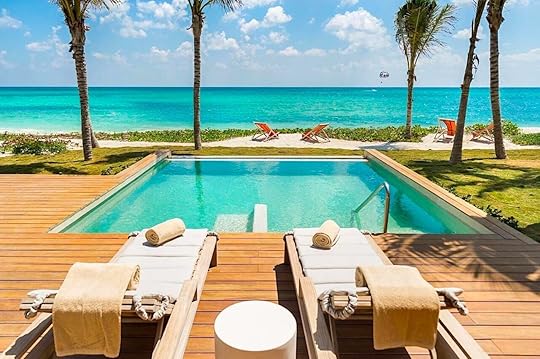
Photo: Booking.com

Photo: Booking.com
For a true five-star luxe romantic resort experience with excellent service, check into the Andaz Mayakoba Resort Riviera Maya. Located just 35 minutes south of Cancun, it is one of five luxury resorts in the 500-plus-acre gated Mayakoba development complex. Guests have signing privileges at the spas and restaurants of all resorts in the complex and a free shuttle service transfers you between them. If you golf, the development also is home to the championship PGA El Camaleón Mayakoba Golf Course.
The Andaz has the two best restaurants in Mayakoba: award-winning Casa Amate and Sotavento. We love Sotavento, which does wood fire-grilled seafood and fresh salads al fresco on the beachfront for dinner. To check out another property, however, take the shuttle over to the Banyan Tree Mayakoba, for dinner at their signature Thai restaurant Saffron.
The Andaz also sits on a lovely stretch of turquoise meets white sand beach. Rooms and suites are artsy, modern and blend perfectly into the surrounding environment. The Naum Wellness Spa here is worth your time. Try the Naum Signature Ritual, which combines volcanic stones, Swedish rhythmic techniques and aromatherapy in a blissful 90-minute session.
2. The best eco-friendly resort in the Riviera MayaHotel Poc Na Tulum

Photo: Booking.com

Photo: Booking.com

Photo: Booking.com
For eco-friendly romance, it is hard to beat the Hotel Poc Na Tulum, which is set on a stunning stretch of Riviera Maya beachfront inside the protected Tulum National Park. Away from the hustle of the Hotel Zone, this small hotel takes its pledge to sustainability seriously and has done a good job of preserving and blending into the surrounding jungle.
The rooms and suites here are self-contained units that are rustic-luxe with Caribbean style. Some have ocean views, others face the jungle. Our favorite rooms come with private plunge pools and hammocks on porches facing the sparkling blue sea.
Despite its small size this Tulum hotel is home to four restaurants and the food is excellent at all. The Kogure Japanese Kitchen Restaurant is a real treat. Resident chef Yusuke Kogure is one of Mexico’s top international chefs and his sushi creations are pure magic.
During the day head to Berna Tulum, where you can order a dozen oysters and a margarita right to your cushioned sun-lounger on the beach while listening to a Latin house soundtrack. After dark Cleo Tulum comes alive with sensual ambiance, music, wood fire cooked seafood and innovative mixology.
3. The best all-inclusive resort in the Riviera MayaHilton Cancun

Photo: Booking.com
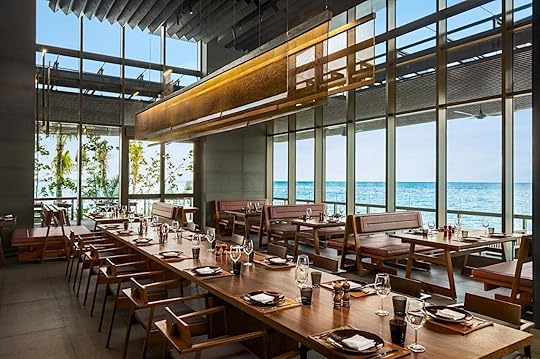
Photo: Booking.com
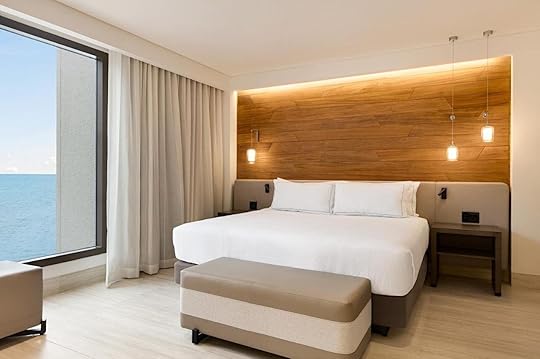
Photo: Booking.com
The brand new Hilton Cancun All-Inclusive is a great, luxury romantic Riviera Maya option if you want to be able to eat and drink to your heart’s content without worrying about the cost. About 20 minutes from the international airport it is easy to access. It is also located down a long, private stretch of road away from the hustle of the Hotel Zone, making it ideal for anyone worried about security.
We love the interior design here, especially in the main lobby area. Rooms and suites come in a number of shapes and sizes. For romance, try a room with a swim-up balcony and sunset views or an ocean-front suite with panoramic views from a wrap-around balcony.
The food and beverage service is also excellent for an all-inclusive property. Drinks are strong and premium spirits are included in the rates. There are multiple restaurants cooking up dishes from around the globe with both buffet and a la carte service. All sorts of tours and activities can be arranged through the concierge. This Hilton is also very dog-friendly!
4. The best boutique hotel in the Riviera MayaLa Zebra a Colibri Boutique Hotel

Photo: Booking.com

Photo: Booking.com

Photo: Booking.com
At the south end of Tulum’s Hotel Zone, the trendy, romantic La Zebra is the best all-around boutique hotel in the area. Set on a gorgeous stretch of beach, the property is part of the network of Small Luxury Hotels of the World and service is top-notch.
The rooms are beautifully designed, self-contained bungalows. There are six different styles and four of these come with personal, jetted plunge pools that kick up the romance level another notch.
La Zebra has a fun atmosphere that can keep you entertained day or night. But its central location also makes it easy to explore other restaurants, bars and shops along the main strip. Note that Tulum’s Hotel Zone is much more boho chill than what you’ll experience in Cancun or Playa del Carmen. You won’t find any mega resorts or clubs here, but lots of beachfront lounges where DJs spin late into the night.
Don’t skip at least a few meals at La Zebra, however. The restaurant faces the sea and serves authentic Mexican fare paired with craft cocktails.
5. The best new resort in the Riviera MayaMvngata Boutique Hotel

Photo: Booking.com

Photo: Booking.com

Photo: Booking.com
Opened in the middle of the pandemic, Mvngata Boutique Hotel is a sexy new Riviera Maya romantic resort on the outskirts of Playa del Carmen. Named for glow of the full moon on the ocean, Mvngata is located on a wide gold sand beach. It has a popular beach club with cabanas and food and drink service right by the sea. The hotel, and beach club, are both dog friendly.
All rooms and suites face the ocean, which is a serious bonus. They are also very stylish with super comfy beds draped in quality linens. The premium panorama oceanfront rooms are massive and come with deep soaking tubs on private terraces with panoramic ocean views, perfect for romance.
The rooftop restaurant and swimming pool is also divine. Start with the tuna tostada before moving on to the stuffed chili with seafood. Pair with a tequila or mezcal cocktail. DJs spin on Saturdays and Sundays.
6. The best adults-only resort in the Riviera MayaMi Amor Hotel Tulum

Photo: Booking.com

Photo: Booking.com

Photo: Booking.com
For romance in intimate environs that is adults-only it is hard to top Mi Amor in Tulum. The boutique property has just over 30 rooms and was designed with love in mind (its name says it all). Set on a cliffside overlooking the sea, the hotel is not in Tulum’s central Hotel Zone, which is a plus for many. Instead, it is just inside the boundaries of Tulum National Park. The entire property is gorgeous and looks like you walked into a designer’s Instagram feed.
The sea view rooms with plunge pools are our personal favorites. There is also a spa onsite and a restaurant and bar. The restaurant features Italian and Mexican classics including a very good pasta Bolognese. For the ultimate romantic dinner, arrange for a private dining experience on the rocks facing the sea.
7. The best resort in the Riviera Maya for active travelersCanopy by Hilton La Isla

Photo: Booking.com
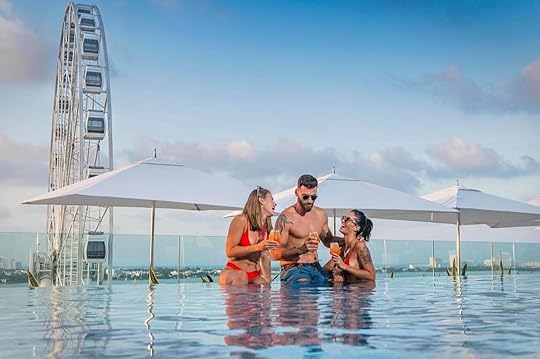
Photo: Booking.com

Photo: Booking.com
For active vacationers who care less about direct beachfront access or an all-inclusive experience and more about exploring the surrounding area, Canopy by Hilton La Isla offers a five-star hotel experience in a less expensive price point. This leaves you plenty of extra cash to check out Cancun’s myriad of activities including diving and snorkeling around the nearby Cancun Underwater Museum.
Located in the Hotel Zone next to the La Isla shopping and dining complex, this property is just a five-minute walk from one of Cancun’s most beautiful beaches. The hotel has a rooftop swimming pool and hot tub as well as sun-loungers and food service. There is a second restaurant in the artsy lobby area. Rooms and suites are spacious and comfortable with fun extras like hanging chairs and murals from local artists.
8. The best beach resort in the Riviera MayaMahekal Beach Resort
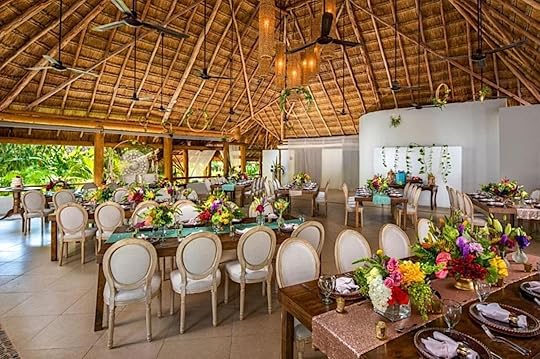
Photo: Booking.com
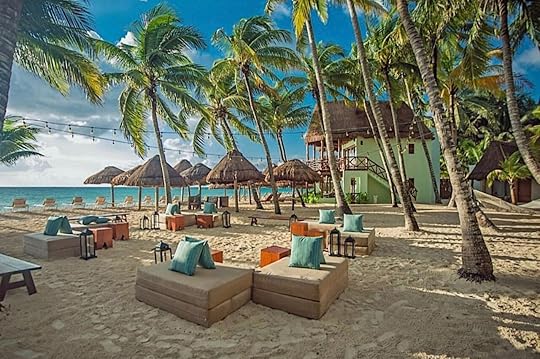
Photo: Booking.com
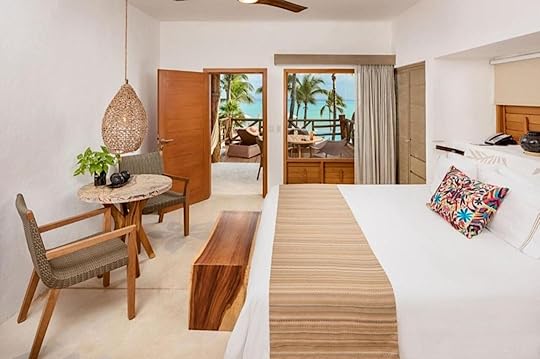
Photo: Booking.com
Right on the beach in the heart of Playa del Carmen, Mahekal Beach Resort is another romantic option that is walking distance from the restaurants, bars and shops on the city’s famed 5th Avenue district. This property has a devoted fan base with guests returning year after year to stay in its boho-chic suites, elegant beach houses and tranquil treehouses surrounded by lots of lush foliage.
There are four pools on the grounds as well as sun-loungers along the beach. If you want to explore the region’s underwater treasures, Mahekal’s respected dive shop can organize snorkels and dives in the ocean and the freshwater cenotes (collapsed limestone caves that are now swimming holes) the region is known for.
The resort is also home to the Revive Spa with a range of Mayan-inspired treatments and relaxing massages. Half and full-board rates are available if you want to have some meals and drinks pre-paid. 
February 14, 2022
New study finds the least stressful seat for your dog during car rides

Suppose you want to take your dog on a long road trip. Knowing your dog is comfortable is an essential part of the journey — and the same is true even if it’s just a short car ride to the dog park. It turns out that one way to minimize your pet’s discomfort is as simple as figuring out where your dog should be seated.
The company Compare the Market conducted a small study to find where your pet is most comfortable going for a ride. The study used four different breeds of different sizes — a Jack Russell, Poochon, Cocker Spaniel, and Red Fox Labrador — and used heart rate monitors to measure their average heart rate versus their heart rate in four different areas of the car: the front seat, the back seat directly behind the owner, the back seat with a view of the owner, and the trunk.
The study found, perhaps unsurprisingly, that pets were most comfortable with a view of their owner. Heart rates spiked when the animals were in the trunk with an average 20.4 percent increase in heart rate, and the second most uncomfortable area was directly behind the owner. In the right part of the car, however, the dogs actually had a lower heart rate than the average taken as a base. Animals felt more comfortable in the front seat with an average decreased heart rate of 6.8 percent from the baseline, but felt the most comfortable in the backseat with a clear view of their human friend, where the dogs had a reduced heart rate of 9.5 percent.
While the study was small with limited data, clinical animal behaviorist Rachel Rodgers explained in study that seating your dog away from your line of sight takes away from the comfort that animals need to feel safe traveling. Keep in mind that some breeds are more likely to take to an adventurous lifestyle more easily when choosing your travel companion. Ensure other comforts like picking your dog up or getting a ramp rather than having them jump into the vehicle and provide some blankets to snuggle up to, and hopefully, you’ll both enjoy some happy dog rides. 
How a couple turned two 19th century Irish pubs into Ireland’s most unique Airbnbs
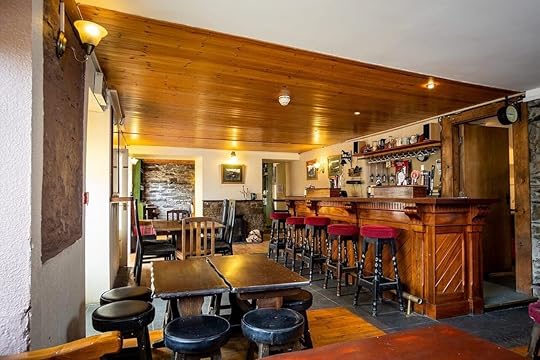
Visiting Ireland without visiting a pub is akin to, well, not visiting Ireland. While popping into the local pub for a trad session is a must-do on any trip to the Emerald Isle, you can now rent your own Irish pub and have your own private party with your crew.
Amanda Coffey owns two traditional pub and guest houses called The Holiday Pub in Tipperary and Cork, and both an are rentable via Airbnb for anyone looking for the perfect spot for a group trip to Ireland.
Each property is historic, but has modern touches. The vibe is much as it was during the pubs’ heyday as operational bars. This means pool tables and game rooms, along with apartment amenities including a kitchen and bedrooms. There’s no reason to drive anywhere, and no reason not to raise another pint. We caught up with Coffey to learn more about how she came into ownership of the pubs and why she put them on Airbnb.
This interview has been edited for length and clarity.
“We have had some funny incidents when confused people have popped in looking for a pint or cigarettes on the way to or from a wedding — assuming it is an open pub — only to find us sitting having our breakfast in our PJs at the bar.”

Photo: Airbnb

Photo: Airbnb

Photo: Airbnb
We hope you love The Holiday Pub in Tipperary and Cork! Just so you know, Matador may collect a small commission from the links on this page if you decide to book a stay. Listed prices are accurate as of the time of publication. See our full Advertiser Disclosure here.
Matador Network: You have two pub properties on Airbnb, one in Tipperary and one in Cork. These must be among the most unique Airbnb properties in Ireland. How did you come to acquire them?Amanda Coffey: The idea started to take shape in 2014. We were living in America and bought an old license being sold — a pub in north Tipperary near lough derg which had been closed for many years — so we could spend time with our large family when we visited Home. We kept the old bar, stage, dance floor, and disco lights for family get-togethers. After we moved back home to Ireland, we thought we would start sharing the fun with others and the idea for Ireland’s largest self-catering holiday pub was born.
What equipment is provided for the pub?The pubs are as if time stood still — but the pubs are fully functioning with all furniture, glassware, dartboards. In Tipperary, there is a stage and a dance floor with a disco lights button, and in Cork, there are pool and air hockey tables also. Big TVs are provided for watching sports.
Guests must provide their own booze, correct?Correct. Customers who have had some bar experience can bring and set up their own Guinness keg and we provide all the equipment for them to do so. The optics are still there for spirits drinkers.
The listing notes up to 16 guests, which is plenty for a lively night. Do guests frequently have trad music sessions in the pub?Absolutely! They are both ideal for a music session. Shane McGowan celebrated his 60th birthday in the Holiday Pub Tipperary, and by all accounts it was quite the night, and it is rumored Glen Hansard and others took to the Stage.
What is the history behind The Holiday Pub in Cork, and why isn’t it a functioning commercial pub anymore?The License was sold long before we purchased the property, so I am not sure why the pub closed down. The pub dates back to the 1800s when the original three cottages were converted into a public house. The pub was open to the public until 2017.

Photo: Airbnb
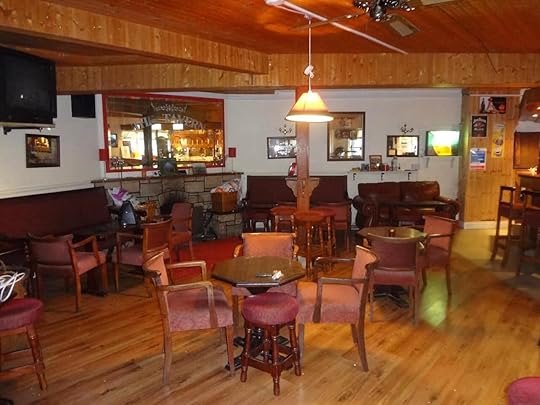
Photo: Airbnb

Photo: Airbnb
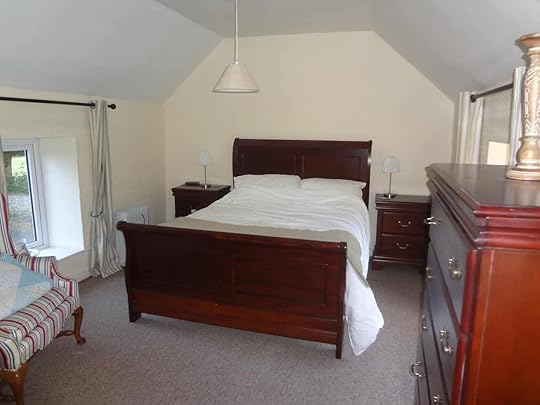
Photo: Airbnb
Do the neighbors ever pop over to The Holiday Pub to say hello for a pint?No, when guests rent the pub it is theirs and they will not be disturbed by our lovely neighbors. However, we have had some funny incidents when confused people have popped in looking for a pint or cigarettes on the way to or from a wedding — assuming it is an open pub — only to find us sitting having our breakfast in our PJs at the bar.
What are some other interesting facts about the property?The license was only the second pub license in the whole of Ireland and the original owners were also called Coffey, so we feel it was fate that we bought it.
I’m sold! Calling the bottle shop now to tell them to stock up. What else should people know about the property?The Tipperary pub sleeps 16 with four bathrooms and this was such a great success we decided to keep an eye out for another.
For the Cork pub: In 2021 we found a pub for sale between Bantry and Glengarriff, also sleeping 16 with four ensuite bedrooms and two other bedrooms which share a bathroom. We upgraded the pub to include a pool table, large living room, and games room with air hockey and darts, along with hotel-quality bed linen and beds.
Our guests are mostly groups in their 30s and 40s who are getting away from the kids for the weekend and found it hard to find places big enough so they could all stay together.
People cook in the catering kitchens but it also brings business to local restaurants and shops. 
One final note : No guests under 25, or stag or hen parties.
Book The Holiday Pub Tipperary
More like thisWhere to StayThe best Airbnbs in Belfast, from the Titanic Quarter to Shankill Road homeWatch: Ghost village that’s been underwater since 1992 recently resurfaced in a Spanish reservoir

The effects of climate change in Spain has unveiled a piece of hidden history. A drought has nearly emptied a dam on the Spanish-Portuguese border and revealed village ruins from 1992. Tourists and locals are flocking to the reservoir that is currently at 15 percent capacity to see the Aceredo village, which was flooded to create the Alto Lindoso reservoir in 1992.
Visitors can find destroyed remnants like partially collapsed roofs, destroyed brick or wooden doors and beams, and the remains of an old car. An old drinking fountain with water still spouting from a rusty pipe, and crates with empty beer bottles were found around a former cafe.
“It’s terrible, but it is what it is,” Jose Alvarez, who used to work as a construction worker in the village, told Reuters. “That’s life. Some die and others live.”
The phenomenon of drowned villages coming to the surface isn’t new. The Tuscan medieval town of Fabbriche di Careggine, which was put underwater in 1946, emerges every once in a while when the Lago di Vagli reservoir in Italy is drained for maintenance. And in 2021, the Italian city of Curon rose to the surface after 70 years of being underwater.
Environment Ministry data shows that in contrast to the 61 percent capacity of Spanish reservoirs in the last decade, they have only reached 44 percent capacity this year. It’s possible the drought could become worse in the coming weeks.
If you’re fascinated by underwater cities, you don’t necessarily have to wait for decreasing water levels to see them, you just need to become a scuba diver. In China, Norway, and other places around the world, there’s plenty of drowned history to find. 
On the Faroe Islands, traditional whale hunts can complicate the decision to visit

Every few years, the whaling practices of the Faroe Islands come under siege. Called the grindadráp, the practice involves rounding up pilot whales and hunting them for their meat and blubber – a centuries-old tradition born from the need to stay warm during the winter. Families who participate carve up the whale meat and allocate it equally, and then it’s frozen to be consumed throughout the year.
The practice is not commercial, and certainly not an activity designed for tourists. Still, activists and visitors to the island have raised concerns about the hunt, which has taken place for hundreds of years. The controversy is mainly rooted in the manner in which the whales are slaughtered.
Hundreds of whales (and sometimes dolphins) are herded into shallow bays each year, and are then killed by knife. Though the modern-day hunt is regulated by the Faroese authorities – you must have an official license to participate – animal rights groups still decry the practice as inhumane. With the ethics of the hunt hotly debated, the issue has spilled over into the country’s burgeoning tourism industry, potentially impacting how visitors view the destination. Rightly or wrongly, the controversial tradition has certainly influenced the global perception of the Faroe Islands, and shaped how the international community views Faroese tradition.
To learn more about how the grindadráp has impacted tourism, we spoke to Páll Nolsøe, communications advisor for the Faroe Islands government.
This interview has been edited for length and clarity.
Matador NetworkWhere did the Grindadráp tradition originate?Páll Nolsøe: Faroe Islanders have caught whales since the time of the Vikings and the Middle Ages, when the distinctive Faroese whaling method was developed. This is the method of hunting in use to this day.
Since the 1980s, new hunting equipment has been developed and introduced, like the blowhole hook and the spinal lance, to ensure more effective killing methods. But apart from these new hunting tools and the use of motorboats, Faroese whaling today is conducted much the same way as in the old days.
To what degree do Faroe islanders still live a subsistence lifestyle where food from hunting and fishing makes up a large part of the diet?Traditional means of food production from local resources are still an important supplement to the livelihoods of Faroe Islanders. These include mountain grazing sheep, coastal fishing for household use, seasonal catches of certain abundant seabirds and occasional catches of pilot whales and other small cetaceans.
These food resources have enabled the Faroe Islands as an island nation to maintain a relatively high degree of self-sufficiency in food production. In the Faroe Islands, it is considered both economically and environmentally responsible to make the most of local natural resources, and to maintain the knowledge required to make use of what nature provides in a harsh oceanic environment.
Pilot whales and other small whales represent one of few local sources of meat that does not have to be imported from afar. The meat from each whale drive provides valuable food which is distributed for free in the local communities where the whale drives take place. This is protein that would otherwise have to be imported from sources in other countries.

Photo: KasperFiil/Shutterstock
The tradition has become controversial in the international community. Is there similar controversy among the Faroese, or is it widely accepted by locals?An opinion poll from September 2021 shows that 85 percent of Faroe Islanders believe that the Faroe Islands should continue to hunt pilot whales. Nine percent believe that the pilot hunt should stop, while five percent are unsure.
In your experience, do tourists ever raise ethical concerns about the grindadráp, or simply accept it as part of Faroese tradition?My ministry sometimes receives letters of protest from people who say they do not want to visit the Faroe Islands because of whaling. At the same time, we regularly receive inquiries from tourists who want to get more information about whaling in the Faroe Islands, and not least about whether it is possible to experience a whale drive and how to do so. So my experience is that among tourists who visit the Faroe Islands, there is an acceptance that whaling is part of Faroese society and way of life, and also an interest in knowing more about whaling.
Does grindadráp figure into the tourism experience at all? Can visitors participate?Whaling takes place in the public space, so everyone has the opportunity to see a whale catch. But since whaling is not scheduled, but happens when a school of whales is spotted by chance, it is not possible to plan a whaling experience as a part of a visit to the Faroe Islands. Anyone can participate in whaling in the Faroe Islands. But only persons who have participated in a pilot whaling course and received information about whaling legislation, use of whaling equipment, killing methods, criteria for establishing death and been issued with a course certificate are entitled to kill whales.
Three Mexican slang words

Mexico has its own language not instructed by Spanish schools and phrase books: Mexican slang. It’s an informal language whose meanings shift in a heartbeat from insults to compliments, a language Mexican people manipulate deftly and instinctively in all sorts of contexts. The following three Mexican slang words and phrases will give you a base for you to attempt to understand and blend in with the locals.
Mexican slang word #1: CabrónA cabrón can either be a badass or a real jerk, a male you talk about with disgust or fear.
There’s also the feminine version, cabrona. Same standards apply: There are the the revered, awe-inducing cabronas and the detested ones.
Then there’s “qué cabrón,” a phrase used to describe a thing or situation as opposed to a person. This, too, can be positive or negative, but it’s got a particular edge to it. For example:
1. Narcos entered a popular restaurant and collected the cell phones of all the customers, warning them not to make any phone calls or act out of the ordinary. The narcos ate peacefully, returned the cell phones, paid everyone’s bills, and continued on their way. Qué cabrón.
2. You ran out of water, and the government isn’t sending more water to the Centro Histórico for three days. You just had a party and now have a sink full of beer glasses, skillets full of chipotle sausage residue, and greasy plates. Qué cabrón.
Insider tip for Mexican slang mastery: For added flair, add an “ay” before cabrón when used for people, and mix it up with an “está cabrón” instead of “que cabrón” in the case of situations.
Mexican slang word #2: MadreIn the quintessential Mexican read, The Labyrinth of Solitude, Octavio Paz has a great passage about the significance of la madre (“the mother”) in Mexican slang and culture.
The madre is identified with all things negative, the padre with all things positive. This, argues Paz, is a reflection of two historical and cultural factors in Mexico.
The first is the idea of the long-suffering mother, the passive recipient of pain and burden who is, to use another classic Mexican slang term, chingada (meaning “screwed,” for a polite interpretation).
The second is the historical resentment and resignation towards the woman whom Paz claims is the mother of modern Mexico — La Malinche. La Malinche was a Nahuatl woman who aided Cortéz in the colonization of Mexico, translating for him, offering insider information, and giving him a son.
So la madre is not treated kindly by Mexican slang. Whether you feel squeamish about it or not, be prepared to hear at least one of the following Mexican slang phrases on a daily basis:
1. Qué madres: what the hell? As in, the sudden explosion of firecrackers on any random street corner, the drunken antics of your friend after too much mezcal, the thing floating in your soup.
2. Que poca madre tienes: literally, how little mother you have, this Mexican slang phrases when directed at you means that you’re so rude and act so badly that it’s like you had no mother to raise you.
3. Es poca-madre: The hyphen and the use of the verb “ser” makes all the difference — it translates as “amazing.” So if Mexico kills in soccer with a 5-0 victory, it’s definitely poca-madre.
4. Hasta la madre utterly sick of something. Your boyfriend’s behavior could drive you to feeling hasta la madre, and so could consistent rain every afternoon or the incessant barking of the dog next door. You’re at the end of your rope, the breaking point. To translate the phrase directly, you’re almost “to the point of motherhood.”
5. Padre: Means “cool.” Plain and simple. So if you score great concert tickets for you and your friends, it’s padre.
Mexican slang word #3: HuevosThere’s a whole linguistic universe surrounding huevos here, so let’s just stick to the most commonly used.
1. Qué huevón/huevona: “What a lazy egg.”
2. Qué hueva: It translates literally as “what egginess.” Eggs here have the same association with laziness with an additional component of boredom. For example, you could toss out a “que hueva” at the suggestion of watching soccer on TV.
3. Qué huevos: A brilliant expression that translates most accurately as “what balls” but really, contextually, means so much more. In the most literal sense que huevos can be used to express admiration for some great courageous act. It can also be used, however, to express repulsion for rude behavior. 
A version of this article was previously published on August 18, 2009, and was updated on February 14, 2022.
More like thisLanguagesThe 27 funniest Mexican expressions (and how to use them)February 11, 2022
Hattiesburg’s Freedom Summer Trail helps illuminate Mississippi’s place in Civil Rights history

Monumental change doesn’t always start in big cities. Sometimes some of the most significant moments in history begin in small towns.
Hattiesburg, Mississippi, was a key hub for advancing the voting rights of Black Americans in Mississippi during the Civil Rights movement through a voter registration drive called Freedom Summer that attracted more than 90 volunteers from out of state, 3,000 local participants, and 675 Freedom School students. Hattiesburg held the largest initiative in the state, outpacing bigger cities like Jacksonville and Gulfport.
January 22, 1964, will be forever known as Freedom Day. On this day, hundreds of Black Americans stood all day in the rain as they prepared to enter the Forrest County Courthouse to register to vote. Peaceful demonstrations continued for months. In July and August 1964, Freedom Schools were established in seven of the community’s churches that included classes with subjects like civics and negro history that, similar to today, were often ignored in public schools. The Freedom Schools became such an overwhelming presence that Hattiesburg became known as “the Mecca of the Freedom School World.”
Students at Palmer’s Crossing Freedom School later authored the “Declaration of Independence” adopted at the statewide convention of Mississippi Freedom Schools in 1964. The “Declaration” also became a part of the platform for the Mississippi Freedom Democratic Party that same year.
The city of Hattiesburg has memorialized this movement by creating the Freedom Summer Trail. The 16-stop trail allows visitors and locals alike to see first-hand some of the most important historical areas in the town — and in the state of Mississippi.
To learn more about Hattiesburg and the impact of Freedom Summer and the Freedom Summer Trail, we caught up with the executive director of Visit Hattiesburg, Marlo Dorsey.
This interview has been edited for length and clarity
Matador Network: Can you tell me a little bit about Hattiesburg today?Marlo Dorsey: We cover our metropolitan statistical area of about 150,000. We’re a two university town, and we have a very dense population of Millennials here, believe it or not. We’re also known as the hub city because of the way that we’re structured geographically – a lot of major interstates and highways all converge here in Hattiesburg. What that meant many years ago is that people automatically came to the city of Hattiesburg for commerce and education, but they also came here for entertainment.
We’re a relatively new Southern city, meaning we were created after the Civil War. And so the railroads and the timber industry is what really gave rise to Hattiesburg over the last century or so. When we look back at the last several decades, we’ve seen that, because we are that natural melting pot with all roads leading to Hattiesburg, we’re a lot more progressive of a community than many other places throughout the Southeast.
What was it about Hattiesburg that made it the center of Freedom Summer in Mississippi versus a larger city like Jackson?
Photo: Visit Hattiesburg
When we look back at the early ‘60s, and specifically with Freedom Summer in 1964, several key people in Hattiesburg’s history played a tremendous part in our Civil Rights movement. There’s a gentleman named Vernon Dahmer, who was the local president of the NAACP. And his core work and mission during this critical and pivotal part of American history was to ensure that people of all backgrounds had the right to vote. In fact, he is famous for saying, “If you don’t vote, you don’t count.”
During the summer of 1964, as the Civil Rights movement continued to garner national attention, activists came from all parts of the country to Hattiesburg. Hattiesburg became the Mecca for the Freedom School movement, where we worked hard to get our schools integrated and ensure that people had the right to vote. In 1964, the poll tax, which is just completely unconstitutional as we see it now, was imposed. Vernon Dahmer worked very hard to raise funds to pay the tax for people so that if they were of African American descent, they could have the right to vote.
At the courthouse at Forrest County, people gathered and they marched and stood up to allow people of all backgrounds the opportunity to vote. And at the same time this movement is going on, there are people from all over the country coming with the Freedom Riders to ensure that education would be equal and everyone, regardless of their background, could have access to quality education. It was just such a tremendous part of that moment in history for how Hattiesburg earned that prominent place as the largest Freedom Summer site in the state.
On one side, there are the historic markers highlighting the sites of Freedom Summer, but on the other, there’s the legacy of Forrest County, with a name coming from a Confederate general and the first leader of the Klu Klux Klan. How does the Freedom Summer Trail tell the story of Hattiesburg’s complicated place in American history in ways that people can only understand by visiting the sites versus reading about the movement in a textbook?
It’s no secret that Mississippi’s past is certainly filled with a lot of ugliness. And the scars of our past should serve as learning opportunities for how we all need to be able to move forward and appreciate one another and grow together. While we cannot change the past, we can certainly learn from it.
In that summer of 1964, 90 volunteers from outside of the state came to Hattiesburg, 3,000 local participants, and 675 Freedom School students were all part of the Freedom Summer movement. We need to make sure today that we are doing everything we can all these years and decades later, to talk about how this was a monumental pivot point for us to do more and ensure equal rights for everyone. We feel like it’s our job at Visit Hattiesburg to understand the history, communicate the facts, and show how that was indeed a turning point in the history of Hattiesburg and its role in advancing the Civil Rights movement.
Why did the city decide to go the route of an interactive self-guided tour versus something like a central museum?
Photo: Visit Hattiesburg
There are a lot of components in Hattiesburg promoting its attractions in the Civil Rights sector. We have several museums that are actually in the works. Hattiesburg is home to the African American Military History Museum, and it just celebrated its 75th anniversary just a few years ago. Also in the works right now is the historic Eureka school that’s gradually being turned into a Civil Rights museum.
But we all know and understand what happened in March of 2020, and that was the COVID-19 pandemic that disrupted all of our plans. We had begun the Freedom Summer Trail, which was a self-guided audio tour several years before that. At the height of the pandemic, we wanted to focus on presenting quality, authentic experiences that were compelling for people who were pent up inside but wanted to get out and do things while also social distancing. So we put a significant amount of time and resources into further developing the Freedom Summer trail from the standpoint of you don’t even have to get out of your car. You can do it on your own schedule. You can even do it online virtually using all the videos and 360 tours we have.
Do you have any favorite stops on the Freedom Summer trail?
Photo: Visit Hattiesburg
We’ve really enjoyed capturing the oral history with people who were there. We still have many people in our community who witnessed all of this firsthand. We enjoy visiting all 16 sites, but one of the most notable ones on our trail is the Vernon Dahmer memorial, of course, being in that place right there in front of the Forrest County courthouse.
We recently had a beautiful bronze sculpture unveiled there, and Mr. Vernon Dahmer’s widow Ellie Dahmer was there, as well as his children, when we had that dedication. Additionally, two voting rights bills are currently in the Senate, and President Biden’s recent speech in Atlanta on voting rights tied back into if you don’t vote, you don’t count. So we’re getting a lot of attention, certainly on this specific site.
Another one is Mount Zion Baptist Church, which where Dr. Martin Luther King stopped during that summer shortly before he was assassinated just a few months later. So there’s a lot of living history that’s here for people to see.
Beyond Vernon Dahmer, are there other civil rights leaders highlighted in the Freedom Summer trail that you think are typically left out of the conversation?We have Raylawni Branch, who is very significant in her role. We also have Clyde Kennard. Clyde Kennard was instrumental as the first Black student at the University of Southern Mississippi. He was first denied admission and arrested, but kept fighting to gain admission. Ultimately, he went on to receive his doctorate. Clyde Kennard is certainly a pinnacle figure in advancing equal rights for education. His marker was unveiled four years ago, and it’s part of the Mississippi Civil Rights trail.
I had the pleasure of being there for the unveiling, and the humility you feel standing there on a beautiful day, on a campus where today so much is taken for granted in terms of equal rights — regardless of your race, your gender, your religion. Just seeing what so many people had to fight for such a short time ago to get us to where we are today, it was such a tremendously humbling moment for us. It was sort of a testament of living history on how far we come and we still have such a long way to go. But we need to celebrate those successes and hold these heroic people in high regard because they paid such a significant price to continue advancing Civil Rights.
Why is it so crucial in modern America for people to see the sights of the Civil Rights Movement firsthand, and what do you hope people who participate will take away from this interactive journey?Civil rights should resonate with everyone from all walks of life. We’re born into this life, and we all need to be treated equally and we all need to be provided with the same access to opportunity, regardless of our race, religion, sexual orientation, or how we identify. And this journey with civil rights, specifically, the Freedom Summer Trail, is one important component of our evolution.
As we continue to fight for equal rights, because we’re not there yet, there are still a lot of things in the social arena that we need to ensure. Our role is to make sure we’re promoting Hattiesburg’s story and sharing that story, even the parts of it that are not pretty, and to also share how we’re tied to the larger picture. We’re trying to show all the things that Mississippi has done and that we need to do.
Visit the city of Hattiesburg to embark on the Freedom Summer Trail, or take the tour online.
Eco-friendly luggage is here, and the Osprey Transporter Carry-on proves it

Sustainable travel just keeps getting easier and easier, and nothing makes this writer more excited — particularly when these developments include conserving land and then getting to recreate on said land.
But one aspect of green travel often overlooked is something we use while enjoying the great outdoors – our travel packs. Developments toward more eco-friendly travel packs have progressed steadily in recent years, with brands like Patagonia, Adidas, and Peak Travel making recycled and carbon-neutral travel luggage, toiletry bags, and travel gear. But a sustainably-made, carry-on size pack that does as well in transit as it does in the field has long been an elusive target.

Many brands are starting to use recycled and post-consumer waste in clothing and gear. Photo: Chanchai phetdikhai/Shutterstock
Fortunately, Osprey, maker of durable backcountry packs developed in the harsh desert environs of southwest Colorado, just filled that void. Enter the Osprey Transporter 4-Wheel Hybrid Carry-On, Osprey’s newest travel pack. It’s well-designed, sustainable, loaded with features, and has a great guarantee.
We hope you love the Osprey 4-Wheel Hybrid Carry-On! Just so you know, Matador may collect a small commission from the links on this page if you decide to book a stay. Listed prices are accurate as of the time of publication. See our full Advertiser Disclosure here.
Osprey’s updates to the Transporter are impressive. The brand basically combined the best aspects of each item in its travel-ready Transporter line — the duffel, the carry-on bag, and the pack — and added a multi-position trolley handle so you can lug it through the airport with ease. It’s easy to pull with spinner wheels durable enough to lug heavy outdoor or work gear; even when it’s full, it slides quite smoothly. And the padded laptop sleeve and large front-panel pocket make it easy to grab a laptop or book in a hurry before you put it in the overhead bin, which should free up space in your under-the-seat bag. It’s great for work travel (or bleisure, if you’re doing it right).
But this is the Climate Win, and it’s the sustainability that really shines. The carry-on is made with 80 percent recycled materials; discarded road barriers, to be exact. (Yes, those plastic icons of construction zones and make-it-or-die hairpin turns.) Osprey uses a water-resistant thick polyester — also recycled — for the front panel, which means that less than 20 percent of the Osprey Transporter 4-Wheel Hybrid Carry-On is new material. It also comes with Osprey’s celebrated lifetime warranty and years of outdoor knowledge, making this new release a solid addition to your sustainable travel gear setup.
The Transporter 4-Wheel Hybrid Carry-On comes with an external toiletry pack, an internal mesh pocket with a mesh divider, and both top and side handles so you can carry it a variety of different ways. The pack is for sale through Osprey directly for $290.
More climate winsThe controversial Mountain Valley Pipeline in West Virginia took another blow last week when the 4th Circuit Court of Appeals overturned a key permit, noting that the pipeline poses an excessive threat to endangered species, per the Virginia Mercury. This marks the third major setback for the pipeline in just the past two weeks, following the same court’s earlier removal of permit approvals from the US Forest Service and Bureau of Land Management.
UK scientists have more than doubled the amount of nuclear fusion power they’re able to generate, CNN reported. Nuclear fusion could be a source of endless clean energy in the future, as its much cleaner than fission and produces less waste. It’s also less dangerous in the event of an accident.

Photo: Maria T Hoffman/Shutterstock
The US Department of Energy last week announced a landmark deal with the government of Puerto Rico to provide $12 billion in federal funding to re-develop the island’s energy grid with a focus on renewable energy. This includes lower-income areas and public housing developments operated by the Department of Housing and Urban Development. The funding could help Puerto Rico become one of the first US states or territories to operate entirely on renewable energy before the federal government’s 2050 net-zero goal. 
The Duke & Dame guide to Miami’s best restaurants and bars, from happy hour to sunrise

Chima Burey first came up with the concept of Duke and Dame, a salted caramel flavored whiskey, after a night out with friends in Miami. After dinner, a friend bought a round of fireball shots for the table, and the cinnamon-flavored whiskey shots sparked a conversation among the group about other potential flavors. Burey shared that he’d love to see a whiskey that tasted like Werther’s Original or Sugar Babies candy, but he never thought the conversation would lead to him starting his own brand of whiskey.

Photo: Courtesy Duke & Dame / AJ Shorter Photography
Three years later, Burey and his long-time friend, Amani Macaulay had a much more serious conversation about their next career steps. Both Burey and Macaulay were in finance at the time and were looking for more fulfilling jobs. Burey brought up his idea of the salted caramel flavored whiskey and after some contemplation, the two decided to go for it.
“Suddenly our kitchens became a chemistry lab, and we were calling each other with different recipes, having our friends and family sample different mixes, and we finally came up with something that we loved,” Burey told Matador Network.
After they found a distillery partner in Florida, the next step was naming the whiskey. Macaulay says that the name they ultimately chose, Duke and Dame, came from the reactions of those who tasted the whiskey for the first time.

Photo: Courtesy Duke & Dame
“Everyone’s eyes lit up when they tasted it. It was contrary to when people take a shot of tequila and they cringe. People said they felt royal and regal when they tasted it, and we wanted something that represented both men and women,” Macaulay explained. “So we started with “Duke” and then we added “Dame” because we envisioned this power couple enjoying their whiskey together.”
Duke and Dame launched in 2017, and since then the brand has won awards at The Sip Awards International Spirits Competition, the New York International Spirits Competition, and the San Francisco World Spirits Competition. The story of Duke and Dame is remarkable because there are so few Black-owned whiskey brands, and the founders didn’t have any experience in the spirits industry when they first started the company.
“Hopefully going forward there are a lot more Black-owned spirits companies where we can be a resource for people who are looking to start a spirits brand or wanting to come into the spirits industry,” Macaulay said. “We didn’t have that. We had to learn a lot of things on our own.”
Because the whiskey was conceived in South Florida, Burey and Macauley also represent their hometown city of Miami when they’re on the road. The city is special to them, not just because of the nearly year round perfect great weather, but because of its cultural diversity.
“Miami’s so much more than partying on South Beach. There’s a bunch of different neighborhoods to explore like Wynwood, downtown Brickell, and Overtown, which is a historically Black neighborhood,” Burey said. “Whether it’s different types of food or different types of music, there’s always something to explore.”
Miami’s food and drinks scene has evolved in recent years, and new restaurants and abrs are popping up on the scene all the time. Burey and Macaulay consider themselves experts when it comes to tracking down the best food and drinks in the Magic City. Here, they share their five picks for Miami’s best bars and restaurants.
Dukunoo Jamaican Kitchen in WynwoodView this post on InstagramA post shared by Dukunoo Jamaican Kitchen 🇯🇲 (@dukunoowynwood)
Wynwood is known for its colorful murals, but it’s also becoming a haven for people who plan their vacation and nights out around what they’re going to eat, with restaurants like Dukunoo Jamaican Kitchen. The restaurant has live music, an “irie” (a Jamaican term for good or nice) otherwise known as a happy hour, and a DJ hosted brunch on the weekends.
“Dukunoo does amazing Caribbean fusion food, and they’re in the heart of Wynwood,” Macaulay said. “We really like them because it’s one of the few representations of Caribbean food and culture within the growing Wynwood space.”
Dukunoo’s menu offers vegan options like curry chickpeas over seasoned vegetables along with traditional Caribbean dishes like jerk chicken, oxtail, and red snapper.
Where: 316 NW 24th St, Miami, FL 33127
Yardbird Table and Bar in South BeachView this post on InstagramA post shared by Yardbird (@yardbirdrestaurants)
For over ten years, Yardbird Table and Bar has been a go-to destination in Miami for Southern comfort food.
“Yardbird is very popular on South Beach, and they’re known for having one of the best fried chicken dishes in South Florida,” Macaulay said.
Both locals and visitors flock here for hearty dishes like lobster mac and cheese and the St. Louis ribs. Another highlight? The great selection of local craft beers.
Where: 1600 Lenox Ave, Miami Beach, FL 33139
Red Rooster in OvertownView this post on InstagramA post shared by Red Rooster Overtown (@roosterovertown)
Miami’s Overtown used to be the meeting place of iconic Black entertainers like Duke Ellington, Ella Fitzgerald, and Aretha Franklin, and the city is now home to another kind of superstar: Red Rooster, a soul food restaurant owned by celebrity chef Marcus Samuelsson.
“Red Rooster is one of our favorite restaurants, and we sponsor a Caribbean night on Sunday nights,” Burey said. “Our partnership works great because we both want to show that Miami is not just a party city, but there’s a rich culture here.”
Some of the best dishes at Red Rooster are the cornbread, fried green tomatoes, and shrimp and grits. The restaurant also has a pool hall on the second floor with live music on special nights.
Where: 920 NW 2nd Ave, Miami, FL 33136
800 Degrees Woodfired Kitchen in AventuraView this post on InstagramA post shared by 800 Degrees Woodfired Kitchen (@800degreescarolinas)
Miami Heat superstars Dwyane Wade and Udonis Haslem are co-owners of this Aventura restaurant that serves up wood-fired pizza, chicken wings, and seafood dishes. Both Wade and Haslem have specialty items on the menu: Wade’s dry-aged beef “All American” burger and Haslem’s fried chicken sandwich are worth making the trip to 800 Degrees Woodfired Kitchen.
Burey said, “The food here is incredible, and the number one selling dessert is the tres leches bread pudding made with Duke and Dame whiskey.”
Where: 2956 NE 199th St, Aventura, FL 33180
Better Days in BrickellView this post on InstagramA post shared by Better Days (@betterdays305)
Located inside a thrift stop, downtown Brickell’s Better Days bar is open seven days a week from 5 p.m to 5 a.m., and the bar caters to the after-work crowd as well as the late-night revelers.
“Better Days is one of the most popular bars in Brickell,” Macaulay said. “This is where all of the industry bartenders come and party and drink. It has great cocktails, a great environment, and a fun location.”
The bar’s arcade games, mismatched furniture, and kitschy decor make it feel like you’re hanging out in a friend’s basement.
Where: 75 SE 6th St, Miami, FL 33131 
These stunning cabins are the ultimate Zion National Park basecamp

From hiking to climbing to horseback riding to going sightseeing, there are many experiences to have at Zion National Park. Ready to dive into all the activities? Here are the most stunning Zion National Park cabins that are perfect for your adventure to the national park and put you right in the middle of the action.
We hope you love the Zion National Park cabins we recommend! Just so you know, Matador may collect a small commission from the links on this page if you decide to book a stay. Listed prices are accurate as of the time of publication. See our full Advertiser Disclosure here.
1. Newly built spacious cabin with grand porch and hot tub
Photo: Airbnb

Photo: Airbnb

Photo: Airbnb

Photo: Airbnb

Photo: Airbnb
Take a family vacation at this grand, newly built cabin on the canyon ridge. This cabin has a spacious living room with a fireplace and windows, stunning views, and a large kitchen. There is also a second-floor patio area that wraps around the house and a bottom deck area with multiple seating areas, and a great place to wake up and have a cup of coffee.
Thirteen guests, five bedrooms
Price: $700 per night

Photo: Airbnb

Photo: Airbnb

Photo: Airbnb

Photo: Airbnb
This two-story cabin is the luxury spot everyone dreams about, located at the East entrance of Zion National Park. It can accommodate up to fourteen guests to be the ideal spot for a family or friend’s gateway. The cabin is near trails East rim, Cable Mountain, and Observation Point.
Fourteen guests, four bedrooms
Price: $500 per night

Photo: Airbnb

Photo: Airbnb

Photo: Airbnb
Relax and reconnect with nature at this quaint cabin. It’s minutes from grocery stores, shops, and restaurants, and is just five minutes from Zion. The cabin features a luxurious queen-sized bed, a private bathroom/shower, spacious cabinetry, granite countertops, and a mini-fridge.
Two guests, one bedroom
Price: $145 per night

Photo: Airbnb

Photo: Airbnb

Photo: Airbnb

Photo: Airbnb
Another perfectly secluded cabin for those looking for more of a serene scene with peace. If you’re someone taking a solo trip and looking for the perfect remote cabin this peaceful cabin may be your pick. This quaint cabin is nestled on the outskirts and has stunning views of the southern side of the Zion mountains. The place has everything one would need, like a bedroom with a queen-sized bed, a living room, and a full bathroom. The perfect experience to immerse in nature and get away from the hustle and bustle.
Two guests, one bedroom
Price: $645 per night
5. Simple rustic cabin perfect for couples or solo travelers
Taking a national parks road trip through Utah’s national parks? Check out Matador’s guides to the best places to stay in Utah:
The best hotels in Utah for a national parks trip The ultimate ‘work and play’ road trip through Utah’s canyon country Salt Lake City’s best Airbnbs for an urban ski getaway

Photo: Airbnb

Photo: Airbnb

Photo: Airbnb

Photo: Airbnb
Welcome to this cozy rustic cabin that’s the perfect place for couples or solo travelers. This secluded cabin is 400 square feet and features a full bathroom, queen-size bed, a loft, and a community fire pit. Guests can also catch the sunrise and sunset on the front porch, and the cabin is only less than a mile away from Zion.
Two guests, one bedroom
Price: $185per night
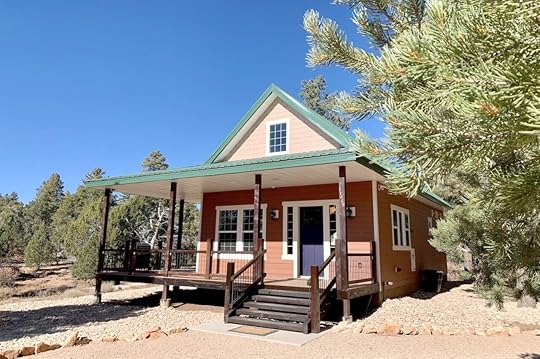
Photo: Airbnb

Photo: Airbnb

Photo: Airbnb

Photo: Airbnb
The perfect cabin that gives all the privacy that one could want. This secluded cabin is on the boundary of Zion National Park. There are two private bedrooms, a large loft bedroom, a fully equipped kitchen, and a spacious living room. If guests want to get outside, there is a wrap-around porch, a grill, and an outdoor fire pit in the backyard.
Nine guests, three bedrooms
Price: $353 per night
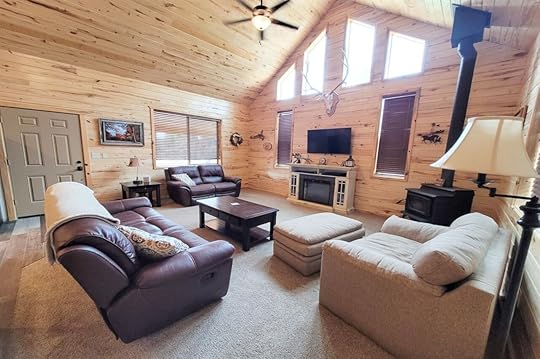
Photo: Airbnb

Photo: Airbnb

Photo: Airbnb
This remote cozy log cabin is perfect for a family vacation. The cottage is just 20 miles from the East Zion National Park entrance. The cabin has a primary bedroom and one other bedroom perfect for the kids. There is a front and back porch if guests would like to wind down outside, and in the back, there is a gas BBQ and a fire pit perfect for roasting marshmallows. Since the cabin is remote, guests can bike and hike to Observation Point, Table Mountain, and DeerTrap or do other sightseeing.
Six guests, two bedrooms
Price: $261 per night

Photo: Airbnb

Photo: Airbnb

Photo: Airbnb

Photo: Airbnb
Take a vacation to a whole other level with this serene, relaxing, cozy cabin. This three-bedroom cabin has a fully equipped kitchen, an open living room with floor-to-ceiling windows, natural lighting, and spacious bedrooms. The home has fantastic views and is within walking distance of Zion National Park.
Eight guests, three bedrooms
Price: $565 per night

Photo: Airbnb

Photo: Airbnb

Photo: Airbnb

Photo: Airbnb
Immerse yourself into all nature has to offer at this convertible a-frame cabin. This unique, quaint rustic cabin is entirely off-grid in nature. At this A-frame cabin, guests can watch shooting stars with a 180-degree view of the sky. There are lounge chairs, hammocks, giant Jenga and cornhole boards, a fire pit, and other fun activities and entertainment. The cabin is located on the border of Zion National Park and is only 140 feet from the East Rim Trailhead.
Two guests, one bedroom
Price: $150 per night

Photo: Airbnb
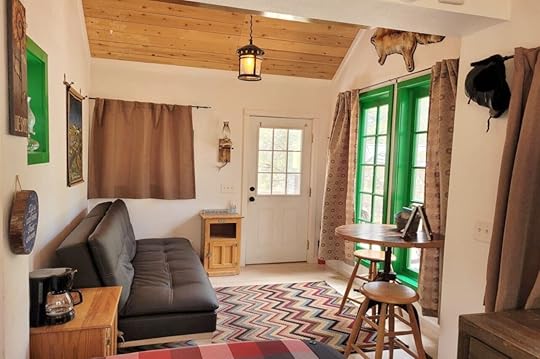
Photo: Airbnb

Photo: Airbnb

Photo: Airbnb
This charming and straightforward cabin offers a peaceful getaway from the busy world. The cabin features a king-sized bed, a futon, tv and also there is a covered outdoor gazebo with an outdoor sink, a mini-fridge, and outdoor seating. The cabin has a separate bathroom area and a large deck with chairs perfect for sitting out and reading a book, and also, there is a fire pit perfect for keeping warm. The cabin is located on the East Rim of Zion and near Cable Mountain and Deer Trap.
Two guests, one bedroom
Price: $209 per night

Photo: Airbnb

Photo: Airbnb

Photo: Airbnb

Photo: Airbnb
Stay at this whimsical tiny home on your next Zion gateway. Named after Mother Eve, this fairytale tiny home is the mother of tiny homes at Zion National Park. The home is fairytale-themed and equipped with a kitchen, living area, a large bathroom with a walk-in shower, and a lofted bed area. Outside is a spacious front porch area with seating, a BBQ grill, and a fire pit to enjoy those beautiful mountain views. 
Two guests, one bedroom
Price: $599 per night
Matador Network's Blog
- Matador Network's profile
- 6 followers



